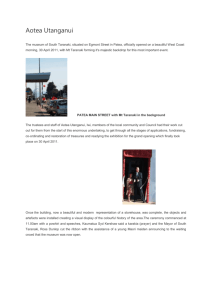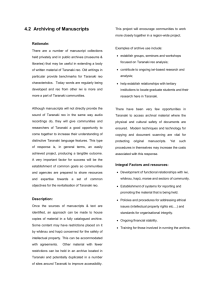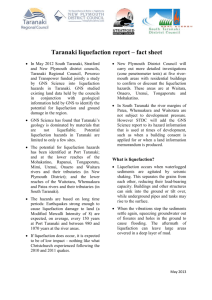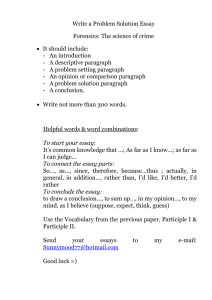suggested activities for this topic
advertisement
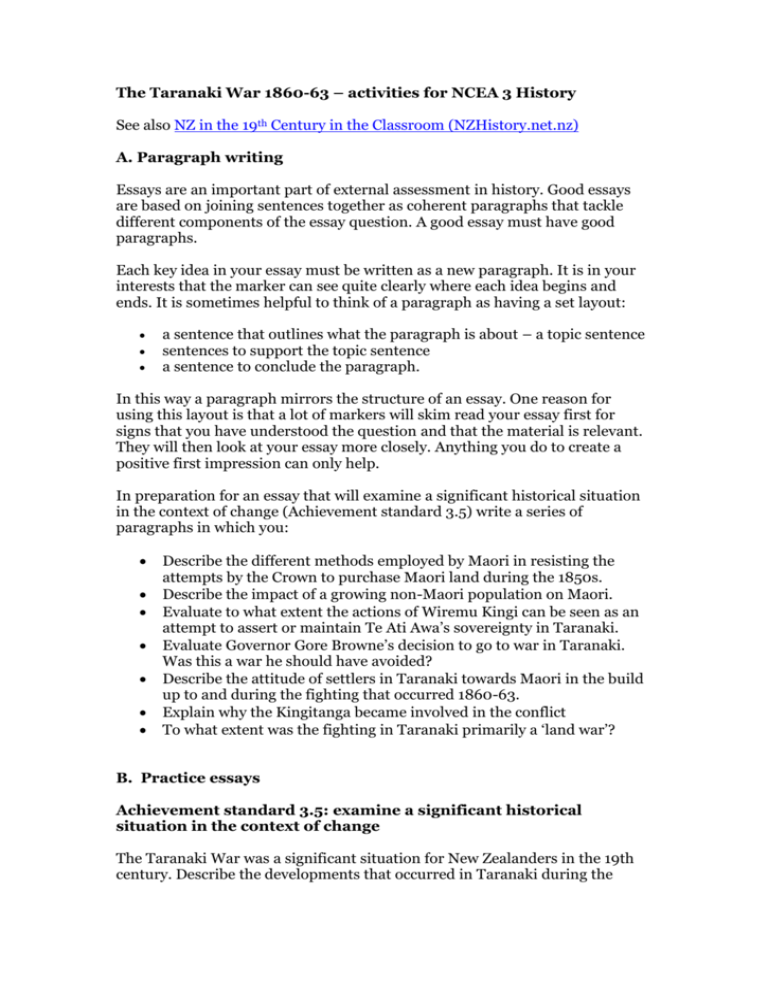
The Taranaki War 1860-63 – activities for NCEA 3 History See also NZ in the 19th Century in the Classroom (NZHistory.net.nz) A. Paragraph writing Essays are an important part of external assessment in history. Good essays are based on joining sentences together as coherent paragraphs that tackle different components of the essay question. A good essay must have good paragraphs. Each key idea in your essay must be written as a new paragraph. It is in your interests that the marker can see quite clearly where each idea begins and ends. It is sometimes helpful to think of a paragraph as having a set layout: a sentence that outlines what the paragraph is about – a topic sentence sentences to support the topic sentence a sentence to conclude the paragraph. In this way a paragraph mirrors the structure of an essay. One reason for using this layout is that a lot of markers will skim read your essay first for signs that you have understood the question and that the material is relevant. They will then look at your essay more closely. Anything you do to create a positive first impression can only help. In preparation for an essay that will examine a significant historical situation in the context of change (Achievement standard 3.5) write a series of paragraphs in which you: Describe the different methods employed by Maori in resisting the attempts by the Crown to purchase Maori land during the 1850s. Describe the impact of a growing non-Maori population on Maori. Evaluate to what extent the actions of Wiremu Kingi can be seen as an attempt to assert or maintain Te Ati Awa’s sovereignty in Taranaki. Evaluate Governor Gore Browne’s decision to go to war in Taranaki. Was this a war he should have avoided? Describe the attitude of settlers in Taranaki towards Maori in the build up to and during the fighting that occurred 1860-63. Explain why the Kingitanga became involved in the conflict To what extent was the fighting in Taranaki primarily a ‘land war’? B. Practice essays Achievement standard 3.5: examine a significant historical situation in the context of change The Taranaki War was a significant situation for New Zealanders in the 19th century. Describe the developments that occurred in Taranaki during the 1850s that led to the outbreak of war in March 1860. Evaluate the influence of these wars on Te Ati Awa and settlers during the early 1860s. Remember structure is important: A good essay must have good paragraphs. Each key or new idea in your essay must be a new paragraph. Think of a paragraph as having a set layout: o a sentence that outlines what the paragraph is about o sentences to support the topic of the paragraph o a sentence to conclude the paragraph. Use the structure outlined below to help you write your answer. Introduction – write an opening paragraph that: identifies the Taranaki War as a significant situation for New Zealand in the 19th century introduces your argument about the significance of this issue. Body – write structured and sequenced paragraphs that: describe the historical context of the Taranaki War and apply terms, concepts and/or ideas related to this issue examine changes, trends and patterns over time related to the Taranaki War evaluate ways in which the Taranaki War influenced people in the historical context. Conclusion – write a concluding paragraph that sums up your main ideas and argument and links them to the focus of the essay. You should aim to write about 600–800 words. For more detail on this achievement standard and criteria open this Word document from the NZQA website Examine a significant decision made by people in history, in an essay Regarding the Pekapeka block, Governor Gore Browne believed that more was at stake than ‘a comparatively valueless purchase’. Explain the factors that led to his decision to ignore Wiremu Kingi’s objections and proceed with the purchase. Evaluate the consequences of this decision for Maori and settlers. Remember structure is important: A good essay must have good paragraphs. Each key or new idea in your essay must be a new paragraph. Think of a paragraph as having a set layout: o a sentence that outlines what the paragraph is about o sentences to support the topic of the paragraph o a sentence to conclude the paragraph. Use the structure outlined below to help you write your answer. Introduction – write an opening paragraph that: identifies the significance of the Crown’s decision to purchase the Pekapeka block at Waitara. introduces your argument about the significance of this decision. Body – write structured and sequenced paragraphs that: describe the decision to purchase the Pekapeka block and the historical context in which this decision was made describe and explain factors that contributed to this decision evaluate the consequences of this decision describe and evaluate views of this decision by contemporary commentators and/or historians. Conclusion – write a concluding paragraph that sums up your main ideas and argument and links them to the focus of the essay. You should aim to write about 600–800 words. For more detail on this achievement standard and criteria open this Word document from the NZQA website C. Both sides of the argument Briefing paper for the Colonial Office Imagine you are Governor Thomas Gore Browne. It is August 1859. You have been asked to prepare a briefing paper for the Colonial Office in London on the progress of the war in Taranaki. The Colonial Office is responsible for determining British policy regarding its colonial possessions and the running of the British Empire. There has been an increase in the number of Imperial troops involved in this war. The new Secretary of State for War and the Colonies, the Duke of Newcastle, is concerned about what has been an increase in costs associated with this war. He wants not only a progress report on the campaign to date but having only been in the post for two months is also seeking an explanation as to why war broke out in the first place. In preparing this report you are also conscious of the fact that you may need further Imperial investment in bringing matters to a successful conclusion. So your report must be written in such a way as to prepare the Colonial Office for the possibility that more expenditure may be needed. Your colonial masters are busy people so are seeking a concise report that gets to the point quickly. You are advised to write no more than 500 words. Wiremu Kingi’s position In April 1860 Governor Thomas Gore Browne wrote to both Te Teira and Wiremu Kingi in a bid to bring the sale of the Pekapeka block to its conclusion. Imagine that you are Wiremu Kingi Te Rangitake. You have just received a letter from the Governor in which he has repeated his willingness to accept Te Teira’s offer to buy the Pekapeka block. He has also indicated that he believes you have no customary rights to this land as you were living at Waikanae when European settlers first arrived. In your written response to the Governor: outline why you oppose the sale of any land at Waitara why you reject Te Teira’s offer in particular why you reject the Governor’s claim that you have no customary rights to land at Waitara D. Settler opinion Either: It is late November 1860. Conditions in New Plymouth have deteriorated and disease has claimed a number of lives in the town. There has been some recent success on the battlefront at Mahoetahi but overall there is no clear sign of a breakthrough. Major General Pratt has overseen the evacuation of a number of the province’s settlers to Nelson, including your wife and three children. You have remained as you are a member of the Taranaki Militia. In a letter written to the editor of the Taranaki Herald outline what you believe should be the next step in bringing this war to a conclusion. You are allowed to use a pseudonym for the purposes of this letter. And/or: It is late November 1860. Conditions in New Plymouth have deteriorated and disease has claimed a number of lives in the town. There has been some recent success on the battlefront at Mahoetahi but overall there is no clear sign of a breakthrough. Major General Pratt has overseen the evacuation of a number of the province’s settlers to Nelson, including your wife and three children. You have remained as you are a member of the Taranaki Militia. In a letter written to family in Devon, England, describe the events of the year and what you believe should be the next step in bringing this war to a conclusion. E. Editorial The Taranaki Herald was the first newspaper published in Taranaki, the first edition appearing on 4 August 1852. Although not always accurate, the Herald was an important source of information on the war and its conduct. Its editorials also presented an opportunity to comment on the management of the war by the government and military hierarchy. Imagine that is Christmas 1860. You are preparing an editorial that reviews the progress of the war to date. You have decided to focus on the leadership of the Imperial forces since the outbreak of war in March. How would you assess the efforts of firstly Colonel Gold and his successor Major-General Thomas Pratt? What do you believe is required to achieve the breakthrough needed for victory as an unhappy year draws to an end? F. Primary sources Instructions You should use your own knowledge in addition to the evidence contained in the sources to answer the following questions. You should aim to write 4–5 sentences for each answer. (1) Using evidence from the Taranaki Punch cartoons ‘Awful impudence’, ‘The policy of war’ and your own knowledge, describe and explain in your own words the attitude of the settler population towards the Imperial military leadership in Taranaki at this time. (2) With reference the cartoon The policy of War and your own knowledge describe in a couple of sentences the attitude of the Taranaki Punch to the Imperial military hierarchy’s conduct of the war in Taranaki. (3) In your opinion how useful and/or reliable is the Taranaki Punch to a historian studying the Taranaki war? (4) Using evidence from the sources below and your own knowledge outline and explain in your own words the different points of view that Governor Gore-Browne and Octavius Hadfield had on the Waitara Land Dispute The Waitara Land Dispute (Thomas Gore-Browne) In March 1859, … Te Teira and others, openly offered to sell to the government their claims to a portion of land in the Waitara. William King1 opposed this offer, and said that no land at the Waitara should be sold. But the ‘mana’ of the land was not with William King, and he had no right to forbid the sale of any land which did not belong to him personally. The Queen has said that all the natives shall be free to sell their lands to her, or to keep them – as they may think best. None may compel the Māori people to sell their lands, nor may any forbid their doing so. William King sets his word above the Queen’s and says, though the rightful owners of the land may wish to sell, he will not allow them to do so. The Governor cannot allow William King’s word to set aside the words of the Queen. … The completion of the purchase of a comparatively small portion of land at Waitara opens up the questions of the Queen’s sovereignty over the colony, the opponents of the sale denying, in fact, not only this, but the right of pre-emption, both of which are secured to her Majesty by the Treaty of Waitangi. Colonel Thomas Gore-Browne, Governor of New Zealand, in the Lyttelton Times, 10 March 1860, p 4. (William King = Wiremu Kingi) Octavius Hadfield and the Taranaki War In 1839 Octavius Hadfield became the Church Missionary Society missionary on the Kapiti coast. In expressing his views on the place of Maori in colonial New Zealand he established a reputation as the ‘political parson’. These views at various times saw him fall foul of political and settler opinion. In 1857 he encouraged Maori to exercise their constitutional right to register as voters for which he was bitterly opposed by Isaac Earl Featherston, then superintendent of Wellington province. However, it was Hadfield's ardent defence of his converts, Wiremu Kingi Te Rangitake and others of Te Ati Awa, now back in Taranaki, which was to make him for some time the most unpopular man in the colony. Grey's successor, Thomas Gore Browne, consulted the archdeacon and other experts regarding Maori land tenure and future government policy, and reported to the Colonial Office on the value of Hadfield's services. Yet the governor rushed headlong into open conflict when in March 1860, in response to settlers' pressure for land, he approved the purchase of Te Ati Awa land at Waitara despite opposition within the tribe. Churchmen led by Bishop Selwyn aligned themselves on the side of Maori tribal rights guaranteed under the Treaty of Waitangi. Hadfield made a direct and public appeal for justice to the Duke of Newcastle, colonial secretary, with three pamphlets: One of England's little wars, The New Zealand war: the second year of one of England's little wars and A sequel to 'One of England's little wars', published in London in 1860 and 1861. The clergy were concerned at the 'intemperate unwise language' used by Hadfield to express his deep anger, which resulted from his conviction that war could have been avoided. Many settlers regarded his actions as bordering on treason, especially when his influence was recognised in the petition of 30 March 1860 of Otaki Maori to Queen Victoria for the recall of the governor. Hadfield defended his stand at the bar of the House of Representatives on 14 August 1860. Starke, June. 'Hadfield, Octavius 1814? - 1904'. Dictionary of New Zealand Biography, updated 22 June 2007 URL: http://www.dnzb.govt.nz/ G. The Taranaki War and the Treaty of Waitangi An important historical relationship is between the past and the present. In March 2010 the 150th anniversary of the start of the Taranaki War was marked by the signing of terms of negotiation for a Treaty of Waitangi settlement between the Crown and Te Atiawa. The Prime Minister, John Key, declared that, ‘We [the government] are negotiating redress for what the Waitangi tribunal calls unlawful invasion of this region and large-scale confiscation of Te Atiawa lands’. Treaty Negotiations Minister Chris Finlayson noted in the ceremony held at Owae Marae, Waitara, that Taranaki Maori had been unfairly labelled as ‘rebels’ and how the large scale confiscations of Maori land under the New Zealand Settlements Act ‘had a devastating effect on iwi and left them unable to sustain their whanau and hapu.’ The Crown acknowledged that the Taranaki wars and the confiscation that followed, as well as the invasion of Parihaka in 1881, represented breaches of the Treaty of Waitangi. Finlayson was optimistic that this agreement marked a new beginning in the ‘Crown's ongoing relationship with the two tribes of Taranaki Iwi and Te Atiawa’. Some quickly pointed to the historic significance of this move. Professor Paul Moon from the Auckland University of Technology went as far as to say that the signing of these terms of agreement represented ‘the beginning of the end’ for one of the most important grievances from the period of the New Zealand Wars. From the outset of the fighting in 1860 the Treaty of Waitangi had been acknowledged by some – including the clergymen Octavius Hadfield and Bishop Selwyn – as justifying Wiremu Kingi’s resistance to the sale of the Pekapeka block. Governor Gore Browne had been openly chastised at Kohimarama in July 1860 for the Crown’s ‘indifferent regard for the Treaty of Waitangi’. (1) With reference to the material available here on the Treaty of Waitangi and your own knowledge, on what grounds could the Taranaki War be deemed to have breached the terms of the Treaty of Waitangi? (2) Who (or what) described the Taranaki War as ‘an unlawful invasion’? (3) In a paragraph of 8-10 lines outline the role the Treaty of Waitangi can play in resolving grievances between Maori and the Crown in the aftermath of the New Zealand Wars? H. Causes of the war A number of factors have been identified as being the primary causes of the Taranaki War: Settler demands for land Racism Issues of sovereignty and control Maori ‘in-fighting’. Rank these causes from 1-4 where 1 is the most important and 4 the least important. Write a few sentences justifying the rank you gave to each possible cause.
